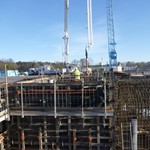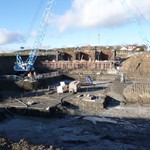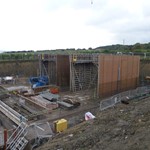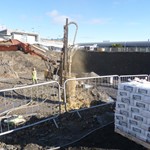Hi everyone. My name is Tom Hornsey; I study civil and structural engineering at the University of Leeds and am currently on a placement year with Interserve. I am working with other engineers to undertake the surveying and setting out of the Actiflo and RGF structures. I will be going into my 4th and final year of study upon completion of the placement.
Below are the latest updates for the construction of the Horsley WTW upgrade.
Further developments have taken place in the Actiflo area. As previously stated, the concrete for the walls of the coagulation tanks in streams 2 and 3 was poured last Friday 21st October. The formwork for these was built just short of the turn in the walls. A vibro poker was used to remove any air voids and the top surface was subsequently finished with a steel trowel. The concrete was left to harden and set over the course of the weekend, allowing the shutters to be stripped on Monday and Tuesday of this week. On Wednesday, construction of the main walls continued. Steel fixing has taken place where the walls surround the flocculation tanks; some of the formwork for these has also been lifted in. On Thursday and Friday, the steel strips for the coagulation tank inside walls of streams 2 and 3 were torn out. The rest of the steel for these walls has been fixed also. The next planned stage of construction of the coagulation tank area is to fix the steel and build the formwork, for stream 1.
In addition, the main tank level slab was planned to be poured where the lamella scrapers are to be set. The steel fixing for this area commenced towards the end of last week and followed on to the start of this week. The locations of the lamella cones and pipework were also boxed out; to prevent the concrete entering them during the pour. The pour itself took place on Thursday; a number of cubes were taken to test the 7 and 28 day strengths of the concrete. Furthermore, slump tests were taken on the concrete as it was being poured, to check the consistency of it was within the required limits. The concrete was finished using a steel trowel and vibro compactor, and jet washed on Friday once it had set.
Work has also continued in the RGF area, where excess water has been pumped out. Following on from last week, large amounts of stone have been bought in to build the ground up to formation level. This process takes time as only so much material can be placed before requiring rolling, so it can be fully compacted. A drainage trench has been formed on the east side of the area, allowing the pipeline to be installed. Previously, six test ground anchors were installed and grouted in different locations around the RGF area. The grout was left to set; stress testing on these anchors then commenced on Wednesday to determine if the anchors are strong enough. The results of the tests will enable a decision to be made on whether they are suitable to be used.
Attached are photos of the latest proceedings. Enjoy your weekend.



































Please Login in order to comment on this update.